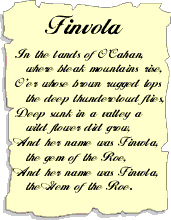|
Many of the legends of Limavady are remembered in place names. The name Limavady itself comes from the story of how the faithful hound of an O'Cahan chief leaped a gorge on the River Roe to get help during an unexpected enemy attack. Another version of the tale tells how the chief made the giant leap on horseback to escape pursuers, they being unable to attempt the same feat. A horseshoe shaped print on the rock of the far bank is absolute proof of the story! Perhaps both stories are true. |
 |
|||
|
Dart Mountain in the Sperrins is named after an ancient sun goddess, according to legend when St. Patrick first prayed here the tabernacle of the sun goddess cracked from top to bottom. |
||
|
Near the source of the Owenreagh River, outside Dungiven is a pool called Lig-na-paistie, were an enormous serpent is said to lie curled up. It used to ravage the adjoining lands until St Murrough prayed to be able to put three bands of rushes on him, and then that these should become bands of iron, thus trapping the serpent forever. |
 |
|||
|
For the Celtic people of Ireland the Bard or Harper was a very important figure. The songs the Harpers sang and the tales they told are an important part of Irish tradition. A small field in Dungiven called Harpers' Walk is the site of a school for Harpers. One of the most famous of the O'Cahan harpers, Toal O'Cahan is said to have composed the well-known ballad "Finvola, The Gem of the Roe". This song tells the story of Finvola, the beautiful daughter of an O'Cahan chief. |
 |
|||
|
|
||||